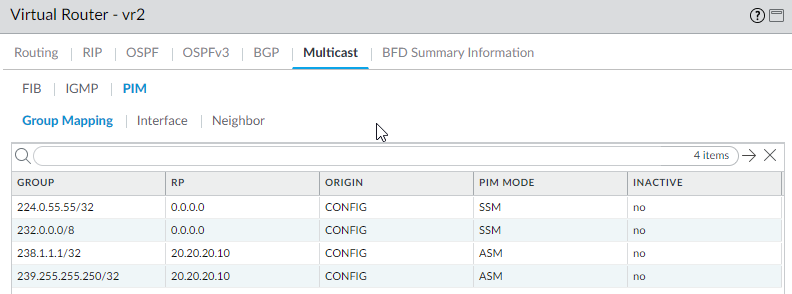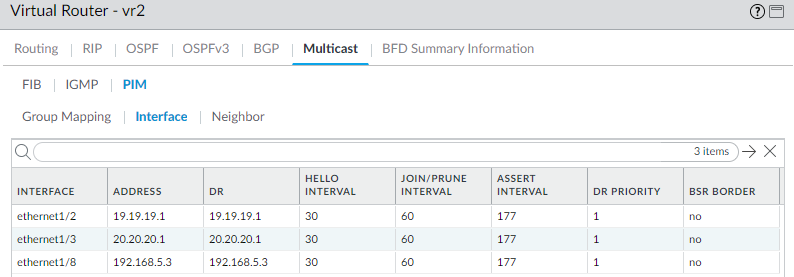Next-Generation Firewall
View IP Multicast Information
Table of Contents
Expand All
|
Collapse All
Next-Generation Firewall Docs
-
-
-
-
-
-
-
- PAN-OS 12.1
- PAN-OS 11.2
- PAN-OS 11.1
- PAN-OS 11.0 (EoL)
- PAN-OS 10.2
- PAN-OS 10.1
- PAN-OS 10.0 (EoL)
- PAN-OS 9.1 (EoL)
- PAN-OS 9.0 (EoL)
- PAN-OS 8.1 (EoL)
-
- PAN-OS 12.1
- PAN-OS 11.2
- PAN-OS 11.1
- PAN-OS 10.2
- PAN-OS 10.1
View IP Multicast Information
View IP multicast routes the virtual router uses, IGMP
interfaces and settings, and PIM information and settings.
| Where Can I Use This? | What Do I Need? |
|---|---|
|
After you Configure IP Multicast
routing, view multicast routes, forwarding entries, and information about your IGMP
and PIM interfaces.
- Select NetworkVirtual Routers and in the row for the virtual router you configured, click More Runtime Stats.
- Select RoutingRoute Table and then the Multicast radio button to display only multicast routes (destination IP multicast group, the next hop toward that group, and outgoing interface). This information comes from the mRIB.Select MulticastFIB to view multicast route information from the mFIB: multicast groups to which the virtual router belongs, the corresponding source, incoming interfaces, and outgoing interfaces toward the receivers.
![]() Select MulticastIGMPInterface to view IGMP-enabled interfaces, the associated IGMP version, IP address of the IGMP Querier, Querier up time and expiry time, the robustness setting, limits on numbers of multicast groups and sources, and whether the interface is configured for immediate leave.
Select MulticastIGMPInterface to view IGMP-enabled interfaces, the associated IGMP version, IP address of the IGMP Querier, Querier up time and expiry time, the robustness setting, limits on numbers of multicast groups and sources, and whether the interface is configured for immediate leave.![]() Select MulticastIGMPMembership to see IGMP-enabled interfaces and the multicast groups to which they belong, the source, and other IGMP information.
Select MulticastIGMPMembership to see IGMP-enabled interfaces and the multicast groups to which they belong, the source, and other IGMP information.![]() Select MulticastPIMGroup Mapping to view multicast groups mapped to an RP, the origin of the RP mapping, the PIM mode for the group (ASM or SSM), and whether the group is inactive. Groups in SSM mode don’t use an RP, so the RP address displayed is 0.0.0.0. The default SSM group is 232.0.0.0/8.
Select MulticastPIMGroup Mapping to view multicast groups mapped to an RP, the origin of the RP mapping, the PIM mode for the group (ASM or SSM), and whether the group is inactive. Groups in SSM mode don’t use an RP, so the RP address displayed is 0.0.0.0. The default SSM group is 232.0.0.0/8.![]() Select MulticastPIMInterface to view the IP address of the DR for an interface; the DR priority; the Hello, Join/Prune, and Assert intervals; and whether the interface is a bootstrap router (BSR).
Select MulticastPIMInterface to view the IP address of the DR for an interface; the DR priority; the Hello, Join/Prune, and Assert intervals; and whether the interface is a bootstrap router (BSR).![]() Select MulticastPIMNeighbor to view information about routers that are PIM neighbors to the virtual router.
Select MulticastPIMNeighbor to view information about routers that are PIM neighbors to the virtual router.![]()






